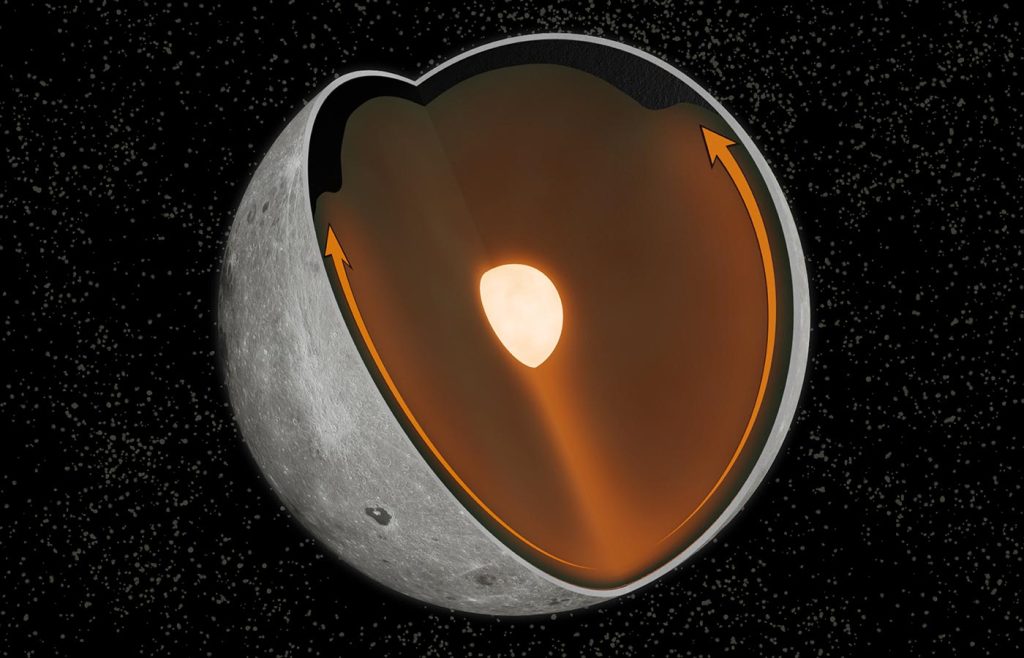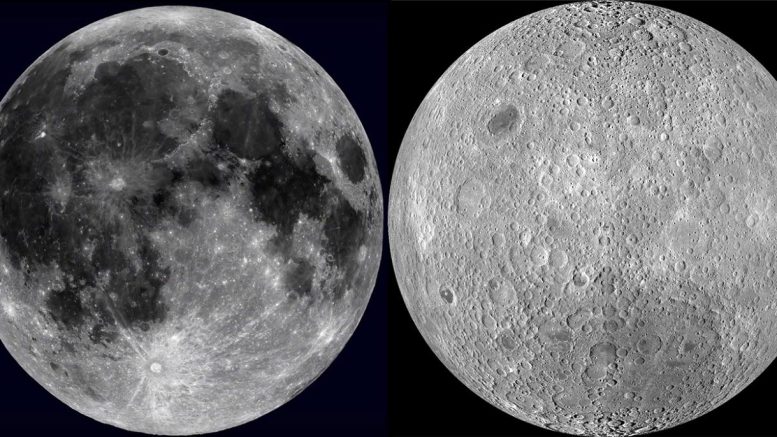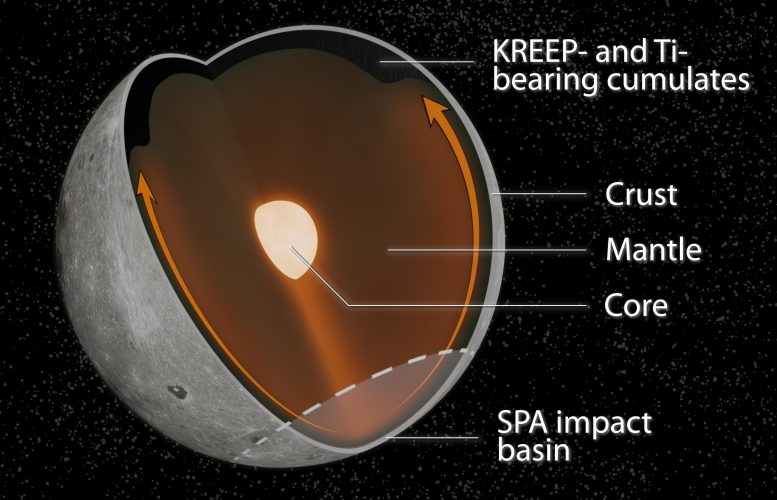
Yeni bir çalışma, ayın güney kutbundaki eski bir çarpışmanın, ay mantosundaki konveksiyon modellerini değiştirdiğini ve yakın taraftaki bir grup ısı üreten elemente odaklandığını ortaya koyuyor. Bu elementler, Dünya’dan görülebilen geniş ay at nalı oluşumunda rol oynadı. Kredi bilgileri: Matt Jones
Yeni araştırma, Ay’ın Güney Kutbu-Aitken Havzası’ndan gelen etkinin, Ay’ın iki tarafı arasındaki kompozisyon ve görünümdeki keskin kontrastla nasıl ilişkili olduğunu gösteriyor.
Ay’ın Dünya’ya gösterdiği yüz, uzak tarafında gizlediğinden çok farklı görünüyor. Yakın taraf, eski lav akıntılarının geniş, koyu renkli kalıntıları olan Ay Persleri tarafından yönetiliyor. Öte yandan, kraterle dolu uzak taraf neredeyse kapsamlı kısrak özelliklerinden yoksundur. İki taraf arasındaki büyük farkın nedeni, ayın en kalıcı gizemlerinden biridir.
Şimdi, araştırmacıların iki yüzlü ay için yeni bir açıklaması var – milyarlarca yıl önce ayın güney kutbuna yakın dev bir çarpma ile ilgili bir açıklama.
Science Advances’te yayınlanan yeni bir çalışma, ayın dev Güney Kutbu-Aitken Havzasını (SPA) oluşturan etkinin, ayın iç kısmına yayılan büyük bir ısı bulutu yaratacağını gösteriyor. Bu tüy, belirli malzemeleri (nadir toprak ve ısı üreten elementlerin bir kombinasyonu) ve yakındaki ayı tutabilirdi. Bu element konsantrasyonu, yakındaki volkanik ovaların oluşumuna yol açan volkanik aktiviteye katkıda bulunmuş olabilir.

Ay’ın yakın tarafında (solda) geniş volkanik birikintiler hakimken, uzak tarafta (sağda) çok daha az yer var. İki taraf arasındaki büyük farkın nedeni, sonsuz ayın gizemidir. Kredi bilgileri: Brown Üniversitesi
Ph.D. Matt Jones, “SPA’yı şekillendiren gibi büyük etkilerin çok fazla ısı yaratacağını biliyoruz” dedi. Brown Üniversitesi’nde aday ve çalışmanın baş yazarı. Soru, bu sıcaklığın Ay’ın iç dinamiklerini nasıl etkilediğidir. Gösterdiğimiz şey, SPA’nın oluştuğu zamandaki herhangi bir makul koşul altında, bu ısı üreten elementleri yakın tarafta yoğunlaştırdığıdır. Bunun, yüzeyde gördüğümüz lav akıntılarına yol açan manto erimesine katkıda bulunduğunu düşünüyoruz. “
Çalışma Jones ve danışmanı, Brown Üniversitesi’nde yardımcı doçent olan Alexander Evans ile Purdue Üniversitesi, Arizona’daki Ay ve Gezegen Bilimleri Laboratuvarı, Stanford Üniversitesi ve Stanford Üniversitesi’nden araştırmacılar arasında bir işbirliğiydi.[{” attribute=””>NASA’s Jet Propulsion Laboratory.

A new study reveals that an ancient collision on the Moon’s south pole changed patterns of convection in the lunar mantle, concentrating a suite of heat-producing elements on the nearside. Those elements played a role in creating the vast lunar mare visible from Earth. Credit: Matt Jones
The differences between the near and far sides of the Moon were first revealed in the 1960s by the Soviet Luna missions and the U.S. Apollo program. While the differences in volcanic deposits are plain to see, future missions would reveal differences in the geochemical composition as well. The nearside is home to a compositional anomaly known as the Procellarum KREEP terrane (PKT) — a concentration of potassium (K), rare earth elements (REE), phosphorus (P), along with heat-producing elements like thorium. KREEP seems to be concentrated in and around Oceanus Procellarum, the largest of the nearside volcanic plains, but is sparse elsewhere on the Moon.
Some scientists have suspected a connection between the PKT and the nearside lava flows, but the question of why that suite of elements was concentrated on the nearside remained. This new study provides an explanation that is connected to the South Pole–Aitken basin, the second largest known impact crater in the solar system.
For the study, the researchers conducted computer simulations of how heat generated by a giant impact would alter patterns of convection in the Moon’s interior, and how that might redistribute KREEP material in the lunar mantle. KREEP is thought to represent the last part of the mantle to solidify after the Moon’s formation. As such, it likely formed the outermost layer of mantle, just beneath the lunar crust. Models of the lunar interior suggest that it should have been more or less evenly distributed beneath the surface. But this new model shows that the uniform distribution would be disrupted by the heat plume from the SPA impact.
According to the model, the KREEP material would have ridden the wave of heat emanating from the SPA impact zone like a surfer. As the heat plume spread beneath the Moon’s crust, that material was eventually delivered en masse to the nearside. The team ran simulations for a number of different impact scenarios, from dead-on hit to a glancing blow. While each produced differing heat patterns and mobilized KREEP to varying degrees, all created KREEP concentrations on the nearside, consistent with the PKT anomaly.
The researchers say the work provides a credible explanation for one of the Moon’s most enduring mysteries.
“How the PKT formed is arguably the most significant open question in lunar science,” Jones said. “And the South Pole–Aitken impact is one of the most significant events in lunar history. This work brings those two things together, and I think our results are really exciting.”
Refernece: “A South Pole–Aitken impact origin of the lunar compositional asymmetry” by Matt J. Jones, Alexander J. Evans, Brandon C. Johnson, Matthew B. Weller, Jeffrey C. Andrews-Hanna, Sonia M. Tikoo and James T. Kean, 8 April 2022, Science Advances.
DOI: 10.1126/sciadv.abm8475

“Analist. Tutkulu zombi gurusu. Twitter uygulayıcısı. İnternet fanatiği. Dost pastırma hayranı.”





More Stories
Bilim insanları dünyadaki en büyük demir cevheri yataklarında milyar yıllık bir sırrı keşfetti
Fosillere göre tarih öncesi deniz ineği, timsah ve köpekbalığı tarafından yenildi
Büyük bir bindirme fayı üzerine yapılan yeni araştırma, bir sonraki büyük depremin yakın olabileceğini gösteriyor